Otranto main monuments include:
The Castle Aragonese
The Castello Aragonese (Castle), reinforced by Emperor Frederick II and rebuilt by Alphonso II of Naples in 1485-1498. It has an irregular plan with five sides, with a moat running along the entire perimeter. In origin it had a single entrance, reachable through a draw-bridge. Towers include three cylindrical ones an a bastion called Punta di Diamante ("Diamond's Head"). The entrance sports the coat of arms of Emperor Charles V.

The Castle of Otranto
The Cathedral
The Cathedral, consecrated in 1088, a work of Count Roger I adorned later (about 1163), by Bishop Jonathas, with a mosaic floor; it has a rose window and side portal of 1481. The interior, a basilica with nave and two aisles, contains columns said to come from a temple of Minerva and a fine mosaic pavement of 1166, with interesting representations of the months, Old Testament subjects and others. It has a crypt supported by forty-two marble columns. The same Count Roger also founded a Basilian monastery here, which, under Abbot Nicetas, became a place of study; its library was nearly all bought by Bessarion.
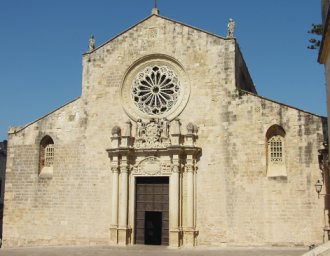
The Cathedral
The Church of San Pietro
Saint Peter's Church is situated in the middle of the old district of Otranto, and dates back to the VIII Century.
It has a plan with a shape of Greek cross inserted in a square perimeter. It has a little monolithic cupola located in the crossing point of the two wings and three apses.
Originally it had a side door/secondary door and an altar dated back to the Six Century.
Inside the church there are eight columns, four of which are free, the others are half stuck in the ceiling.
But what catches, most of all, visitors' attention are the frescoes that represent biblical scenes like: "L'ULTIMA CENA" (THE LAST SUPPER), "LA LAVANDA DEI PIEDI" (GESUS THAT WASHES THE FEET OF THE APOSTLES / THE WASHING OF THE FEET) that lay on the barrel-vault of the north-west aisle; while on the vault of the south wing the fresco represents "IL BATTESIMO DI CRISTO" (CHRIST BAPTISM / THE BAPTISM OF CHRIST).
On the east wall there is S. Peter's niche that has three apses.
The restoration made in 1948 tried to give back to the Basilicas its former aspect lost because of the tampering of time.
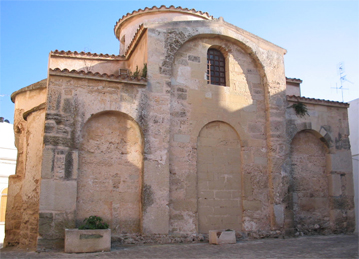
The Church of San Pietro
The Chapel of Madonna of the open sea
Its real name is Chapel of the Holy Spirit, but it is usually known as the Church of the Madonna of the open sea. It is built on a height that slopes down to the sea.
Its history is not very known: in the past it was a little Church in bad conditions because it was trembling down.
In 1744 the inhabitants of Otranto decided to build it up again.
During the post-war, the little Church was subjected to restoration works funded by the fishermen and by the Navy Command, while a Committee of citizens wedded to the Madonna of the open sea projected and ordered the execution of the works.
In recent years, further restorations were made to give back to the religious structure its old glory.
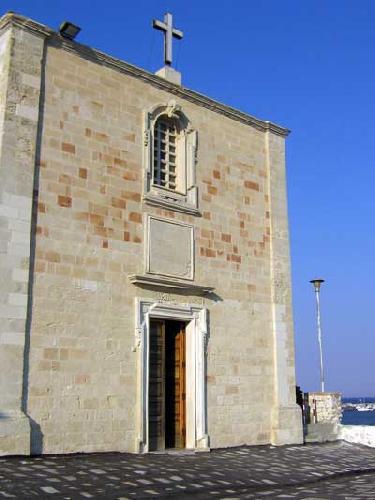
The Chapel of Madonna of the open sea
The Sanctuary of Saint Mary of the Martyrs
The Sanctuary is situated in the southern suburb of Otranto and was erected on the top of a height where in 1480 the Eight Hundred Martyrs of Otranto were decapitated.
It is supposed that, in pre-christian age, in this place there was a temple consecrated to the goddess Minerva. For it the area that surrounds the Church is still called "Minerva".
Duke Alfonso of Calabria, after the massacre, ordered to build the present Church preceded by a long staircase. At the beginning of it, there are two pillars on which, two marble epigraphs remind visitors of the tragic event occurred in1480.
Today's baroque Sanctuary, was built in 1614 in the same place where the former Martyrs Church rose but it is consecrated to San Francesco di Paola, Otranto patron saint together with the (Blessed) Martyrs.

The Sanctuary of Saint Mary of the Martyrs
Inside the Sanctuary, on the left side, an epigraph stands out on a marble plaque, wanted by the Archaeologist Luigi Di Simone, that describes what happened during the slaughter.
Along the walls of the Church there are also (some) marble boards that quote the names of some Martyrs.
The high altar created with pietra leccese (a type of stone quarried in territory around Lecce), follows the Baroque style of the Church.
Moreover, it's easy to admire a Zoppo's canvas that lies on the ceiling, reproducing "LA PRESA DI OTRANTO" (OTRANTO'S TAKEOVER).
The Old Town
Otranto takes its charm (above all) from its old town that stood up to storm of time and nowadays is the same of the past.
You enter this old part of Otranto from "Porta Terra" that brings you to a rampart of Napoleonic age. Once entered the heart of the little town, you are in a triangular square, created in the second half of XIV Century.
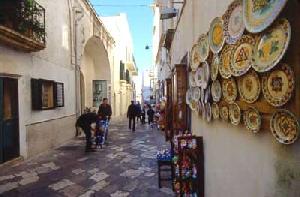
The Old Town
Going forward rises "Porta Alfonsina", built in 1481 and dedicated to Alfonso Duke of Calabria, thanks to whom Otranto was set free from Ottoman control.
It is exciting to walk upon the old paving made by cobblestones.
Via Garibaldi is the main street of Otranto's trade: it brags about numerous little shops that stay opened until late at night, where you can find everything.
This street ends up in "Piazza del Popolo" in which you can notice "La Torre dell'Orologio" built in 1799 and embellished with the citizens' coat of arms.
Afterwards, among pubs and bars, you arrive at "Porta a Mare", throughout which, getting down a long wooden staircase, you arrive at the port.
The old town winds through a busy web of tiny streets where you can admire old buildings dating back to different ages.
From the seaside rises "Bastione dei Pelasgi": if you look across from here you perceive a quaint and wonderful landscape of the port.
Moreover, in the heart of the old part of Otranto you can find St. Peter's Church; at the top of the town the Cathedral and the Seminary, while the Aragonese Castle is situated in direction of the sea.
Another noteworthy thing is that if you look at the edges of some houses in the tiny streets you will find some granite balls that were shot by the Saracens' bombards in 1480.
The Hypogeum of Torre Pinta
Salento's territory brags about numerous examples of dovecot towers spread out in the XVI Century.
Few kilometres away from Otranto, towards the southern side, in "Valle delle Memorie" rises a hill upon which is erected "Torre Pinta", a circular tower that dominates the surrounding landscape. It is an example of dovecot tower, built in a settlement, perhaps of Christian people, dating back to the previous age, for its Latin cross shaped plan.
The three short wings of the cross are oriented to the West, South and East; while the dark gallery, that corresponds to the long wing of the cross, is oriented toward the North.
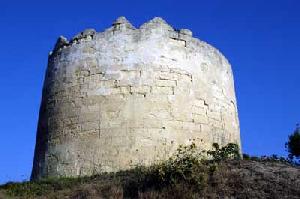
The Hypogeum of Torre Pinta
All the niches and the wide corridor with its low ceiling, present deep incisions caused by pigeons' nails. If you look at the walls with more attention, you notice some details that directly remind of Messapic culture: a furnace/crematory used for cremations and sacrifice; hundreds of cavities used as urns and a stone step along the entire walls, used, according to that people's custom, to leave the dead sat down.
Today the most reliable hypothesis about the origins of this structure is that of Messapic origin.
This hypogeum was discovered in August of 1976 by the Architect Antonio Susini who comes from Milan, and who firmly asserted that the numerous little cells found there, hosted pigeons bred by the owners of the near farm.
In addition, the strategic position of the place gives sense to the supposition that there were homing pigeons that ran for the military Command of Borboni that garrisoned the territory of Otranto.
Only the tower dates back to the Middle Age, but it was subjected to different recreations. This part is certainly the oldest in fact is characterized by oriental spires of Saracen inspiration.

